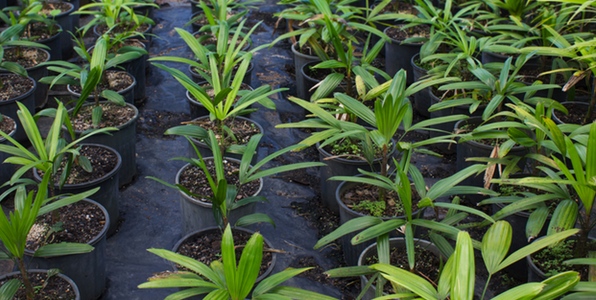Gallery
Click the thumbnails below to view image gallery:Potting palms to some is an easy task. However, when dealing with such an intricate plant, it is important to have a set of steps to ensure optimal growth. The most important part of potting a palm is to know what species it comes from, the conditions that it requires for growth, and the level of maintenance needed to keep it healthy.
Certain aspects such as pot types, soil mixes, watering and fertilization, affect the patterns of growth of a palm, below is a guide to potting.
Choose the Right Pot for your Palm
Having the right pot for your palm is extremely important. Young palms prefer smaller containers for warmth and drainage. The palm would benefit from potting into a larger pot if the soil is exhausted or the roots are coming out of the bottom. This also depends on how large you would like the plant to grow.
If contained in a pot too small, it can die from roots breaking off resulting in internal rotting of the wood. The bigger your pot the better in most cases because the palm will grow to a vast height and weight.
In addition to finding the right sized pot, it is essential that you make sure it has a drainage hole at the bottom to drain excess water.
Know the Best Soil Mixes which is Appropriate for your Palm
Providing the right soil mix for your palm is also crucial. Buy a good quality soil potting mix to match your quality palm. A common misconception is the belief that any kind of soil will work.
Use a soil mix that is free draining but still retains moisture to keep the soil damp and fertile for the growth of the roots. If the soil mix frees too much liquid, you will have to water your palm more frequently and potentially risk drowning it.
Furthermore, make sure to not overfill your pot with soil. There should be at least an inch between the soil and the top of the pot.
Have a Proper Knowledge on How to Water Your Palm
You may be thinking that watering your palm is the easiest part of the process. On the contrary, this is where it pays to know specific details about your palm. Some species of palms require that not only do their roots need watering, but also their leaves. There are some that respond to watering patterns according to the weather and then there are some that do not need to be watered often.
It all depends on the species of the palm. Of course, it is ideal to water your palm on hot dry days. However, suppose it is a cold day with no kind of moisture in the air for the palm to cultivate itself with. It is still crucial to water, taking care to not water the foliage as much because it will increase the chances of crown rot. If the potted palms are inside and are usually watered through the soil as opposed to the foliage, then they will benefit from an outside hosing to remove dust.
Watering with a hose versus watering with sprinklers is at the planter's discretion. However, keep in mind that sprinklers do not have a concentrated like a hose. Pay close attention not to over or under water.
<< Previous A Beginner's Guide to Fishtail Palm Tree Care (Caryota Genus) | Back to Mullumbimby Palm Blog | Next >> Caring For Your Kentia Palm (Howea forsteriana)







